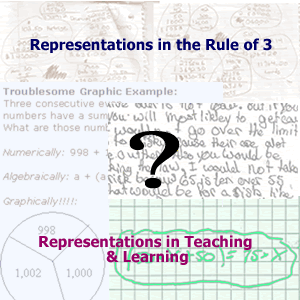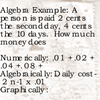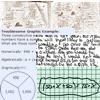
The Development and Use of Representations in Teaching and Learning about Problem Solving: Exploring the Rule of 3 in Elementary School Mathematics
TIMOTHY BOERST
Jane Addams Elementary • Redford, MI
with Ruba Ahmed, Desiree Pointer, and the Knowledge Media Lab of The Carnegie Foundation
Contexts of my teaching & scholarship
Examine the wide variety of contexts that shaped this scholarship.
Collaborative Action Research Context
Take a long or short tour of the process I used to study the Rule of 3.
Created: 11/24/03.
Last updated: 2/9/05.
|
An operational definition, complete with examples of student work and links to descriptions and examples from reform calculus sources. |
Why bother with the Rule of 3? |
Aligning routine tasks & the Rule of 3 Consider examples of the tasks that supported the use of representations and key elements of task creation and use. |
This website is about a mathematical idea, "the Rule of 3," and the myriad of teaching and learning considerations, actions, and reflections that grew out of serious attention to it. The idea is that work on any mathematical topic can beneficially incorporate the use of numerical, algebraic, and geometric/graphic representations. The teaching and learning implications of this idea are numerous and wide reaching.
"the Rule of 3," and the myriad of teaching and learning considerations, actions, and reflections that grew out of serious attention to it. The idea is that work on any mathematical topic can beneficially incorporate the use of numerical, algebraic, and geometric/graphic representations. The teaching and learning implications of this idea are numerous and wide reaching.
-
Who may or does benefit from routine, integrated attention to multiple representations?
-
Where are the strategic places within different mathematical topics where different representations provide special utility or leverage?
-
How might students use different representations in solving particular problems and how might teachers facilitate understanding of the benefits of under utilized representations?
While my exploration of these questions is ongoing, the examples, reflections, and links available on this website provide an entry point for seeing, describing, and analyzing the role of representations as conduits of meaning making and communication, not as discrete topics or skills. This website also attempts to thickly portray the complex array of thought and action that are involved in transforming a mathematical idea into routine classroom practice.
View a PowerPoint file (presented at the NCTM Annual Conference) that provides a streamlined overview of the main elements of my Rule of 3 work.
 |
 |
 |
 |
| Seeing the math within | Understanding new curriculum materials | Roles of representation | All students |
This site requires Acrobat Reader, the QuickTime plugin, and the Macromedia Flash 6 plugin.
